Impact of Tree Crown Transmittance on Surface Reflectance Retrieval in the Shade for High Spatial Resolution Imaging Spectroscopy: A Simulation Analysis Based on Tree Modeling Scenarios
Abstract
:1. Introduction
- Spectral and spatial variations of simulated from TLS-based tree model to different levels of abstraction of tree modeling: What are the differences and where they come from? Which 3D tree representation is best suited?
- predicted from a statistical regression based on a very simplified and empirical tree representation and the variation of several input parameters: What performances can be achieved? What are they when applied to tree models from more realistic scenarios (TLS-based and abstract tree models)?
- Surface reflectance retrieval in the tree shadow by accounting for : Does the performance of the regression built on the empirical tree model fit the retrieval accuracy requirements? What are the contributions of both and to in the radiative budget in the tree shadow and what are the consequences of neglecting them?
2. Materials and Methods
2.1. Study Site and Field Measurements
2.2. General Methodology
2.3. DART Canopy Radiative Transfer Model: Tree Modeling, Simulation Setting, and Transmittance Extraction
- Remote sensing observations: satellite, aircraft, and ground imaging spectroradiometers and scanning LiDAR (discrete return, waveform, photon counting, TLS) systems.
- Radiative budget: 3D, 2D, and 1D distributions of absorbed, emitted, scattered, and intercepted radiation, including the solar-induced chlorophyll fluorescence signal of 3D vegetation.
2.3.1. 3D Tree Modeling Scenarios
2.3.2. Definition of the Fixed and Variable Parameters for Simulation Purposes
2.3.3. Tree Crown Transmittance Derived from Radiative Transfer Budget in the Tree Shadow
2.4. Statistical Regression for the Empirical Tree Model
2.5. Metrics to Compare Tree Crown Transmittances
2.6. Metrics to Assess Surface Reflectance Retrieval Performance
3. Results
3.1. Tree Crown Transmittance for the Empirical Tree Model: Sensitivity Analysis, Regression Building, and Prediction
3.2. Comparison of Tree Crown Transmittances from the Tree Modeling Scenarios
3.2.1. Spectral Analysis
3.2.2. Spatial Analysis
3.3. Reflectance Retrieval Performance
4. Discussion
4.1. Impact of the 3D Tree Modeling from Realistic Scenarios on the Simulated Tree Crown Transmittance
4.2. Limitations of the Empirical Tree Model to Predict the Tree Crown Transmittance
4.3. Impact of the Tree Crown Transmittance on Surface Reflectance Retrieval in the Tree Shadow
5. Conclusions
Author Contributions
Funding
Institutional Review Board Statement
Informed Consent Statement
Data Availability Statement
Acknowledgments
Conflicts of Interest
Abbreviations
| ALA | average leaf angle |
| B and NB () | bias error and normalized mean bias (threshold on NB) |
| BACKGROUND | ground reflectance |
| DBH | diameter at breast height |
| IS | imaging spectroscopy |
| , ,, | irradiance at TOC, total irradiance received at ground, atmospheric diffuse solar irradiance, earth–atmosphere coupling irradiance |
| , , , | transmitted irradiance through the tree crown, its fraction coming from the incoming direct solar radiation, the incoming diffuse part, and the multiple scattering |
| IQR | interquartile range |
| LAD | leaf angle distribution |
| LAI | leaf area index |
| LiDAR | light detection and ranging |
| LOP | leaf optical properties |
| NIR | near infrared |
| NPV | non-photosynthetic vegetation |
| PAI | plant area index |
| POROSITY | percentage of gaps in the tree crown |
| RMSE | root mean square error |
| SWIR | shortwave infrared |
| SZA | solar zenith angle |
| TLA | tree leaf total area |
| TLS/ALS | terrestrial/aerial laser scanner |
| TOC | top of canopy |
| , , | total tree crown transmittance, its fraction coming from non-intercepted transmitted light, and from multiple scattering |
| VISI | visibility |
Appendix A
Appendix A.1. Allometric Equation to Compute LAI
Appendix A.2. LAI-2000 Measurements to Compute PAI and ALA for Both the Linden and Magnolia

Appendix A.3. Comparison of the Results for PAI/LAI and ALA with the TLS-Based Estimations
Appendix B
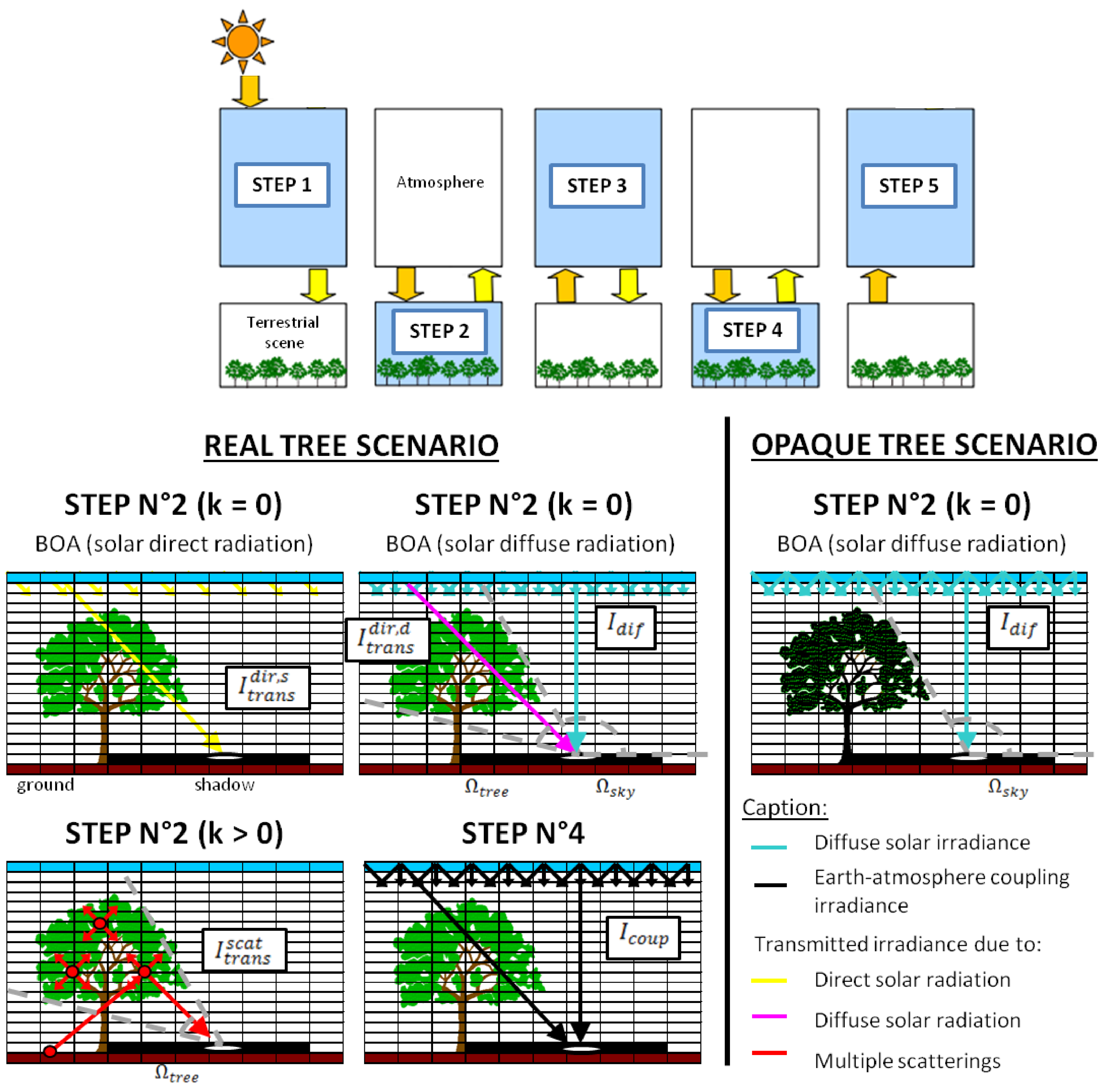
References
- Ustin, S.L.; Roberts, D.A.; Gamon, J.A.; Asner, G.P.; Green, R.O. Using imaging spectroscopy to study ecosystem processes and properties. Bioscience 2004, 54, 523–534. [Google Scholar] [CrossRef]
- Chabrillat, S.; Ben-Dor, E.; Cierniewski, J.; Gomez, C.; Schmid, T.; Van Wesemael, B. Imaging Spectroscopy for Soil Mapping and Monitoring. Surv. Geophys. 2019, 40, 361–399. [Google Scholar] [CrossRef] [Green Version]
- Van Der Linden, S.; Okujeni, A.; Canters, F.; Degerickx, J.; Heiden, U.; Hostert, P.; Priem, F.; Somers, B.; Thiel, F. Imaging Spectroscopy of Urban Environments. Surv. Geophys. 2019, 40, 471–488. [Google Scholar] [CrossRef] [Green Version]
- Damm, A.; Guanter, L.; Verhoef, W.; Schlapfer, D.; Garbari, S.; Schaepman, M.E. Impact of varying irradiance on vegetation indices and chlorophyll fluorescence derived from spectroscopy data. Remote Sens. Environ. 2015, 156, 202–215. [Google Scholar] [CrossRef]
- Fawcett, D.; Verhoef, W.; Schläpfer, D.; Schneider, F.; Schaepman, M.; Damm, A. Advancing retrievals of surface reflectance and vegetation indices over forest ecosystems by combining imaging spectroscopy, digital object models, and 3D canopy modelling. Remote Sens. Environ. 2018, 204, 583–595. [Google Scholar] [CrossRef]
- Kukenbrink, D.; Hueni, A.; Schneider, F.D.; Damm, A.; Gastellu-Etchegorry, J.-P.; Schaepman, M.E.; Morsdorf, F. Mapping the Irradiance Field of a Single Tree: Quantifying Vegetation-Induced Adjacency Effects. IEEE Trans. Geosci. Remote Sens. 2019, 57, 4994–5011. [Google Scholar] [CrossRef]
- Adeline, K.; Chen, M.; Briottet, X.; Pang, S.; Paparoditis, N. Shadow detection in very high spatial resolution aerial images: A comparative study. ISPRS J. Photogramm. Remote Sens. 2013, 80, 21–38. [Google Scholar] [CrossRef]
- Gamba, P.; Lisini, G. Urban land cover mapping using hyperspectral and multispectral VHR sensors: Spatial versus spectral resolution. Proc. URBAN IAPRS 2005, 36, 1416. [Google Scholar]
- Yuan, F.; Bauer, M.E. Mapping impervious surface area using high resolution imagery: A comparison of object-based and per pixel classification. In Proceedings of the American Society for Photogrammetry and Remote Sensing—Annual Conference of the American Society for Photogrammetry and Remote Sensing 2006: Prospecting for Geospatial Information Integration, Reno, NV, USA, 1–5 May 2006; pp. 1–5. [Google Scholar]
- Dare, P.M. Shadow Analysis in High-Resolution Satellite Imagery of Urban Areas. Photogramm. Eng. Remote Sens. 2005, 71, 169–177. [Google Scholar] [CrossRef] [Green Version]
- Shahtahmassebi, A.; Yang, N.; Wang, K.; Moore, N.; Shen, Z. Review of shadow detection and de-shadowing methods in remote sensing. Chin. Geogr. Sci. 2013, 23, 403–420. [Google Scholar] [CrossRef] [Green Version]
- Richter, R.; Schläpfer, D. Geo-atmospheric processing of airborne imaging spectrometry data. Part 2: Atmospheric/topographic correction. Int. J. Remote Sens. 2002, 23, 2631–2649. [Google Scholar] [CrossRef]
- Schläpfer, D.; Richter, R.; Feingersh, T. Operational BRDF Effects Correction for Wide-Field-of-View Optical Scanners (BREFCOR). IEEE Trans. Geosci. Remote Sens. 2014, 53, 1855–1864. [Google Scholar] [CrossRef] [Green Version]
- Richter, R.; Schläpfer, D. ATCOR-4 User Guide; German Aerospace Center: Cologne, Germany, 2016. [Google Scholar]
- Lachérade, S.; Miesch, C.; Boldo, D.; Briottet, X.; Valorge, C.; Le Men, H. ICARE: A physically-based model to correct at-mospheric and geometric effects from high spatial and spectral remote sensing images over 3D urban areas. Meteorol. Atmos. Phys. 2008, 102, 209–222. [Google Scholar] [CrossRef]
- Ceamanos, X.; Briottet, X.; Roussel, G.; Gilardy, H. ICARE-HS: Atmospheric correction of airborne hyperspectral urban images using 3D information. In SPIE Remove Sensing, Proceedings of the Remote Sensing Technologies and Applications in Urban Environments II, Edinburgh, UK, 26–29 September 2006; Erbertseder, T., Esch, T., Chrysoulakis, N., Eds.; International Society for Optics and Photonics: Bellingham, WA, USA, 2016; Volume 10008, p. 100080R. [Google Scholar]
- Adeline, K.; Briottet, X.; Ceamanos, X.; Dartigalongue, T.; Gastellu-Etchegorry, J.-P. ICARE-VEG: A 3D physics-based atmospheric correction method for tree shadows in urban areas. ISPRS J. Photogramm. Remote Sens. 2018, 142, 311–327. [Google Scholar] [CrossRef] [Green Version]
- Sercu, B.K.; Baeten, L.; Van Coillie, F.; Martel, A.; Lens, L.; Verheyen, K.; Bonte, D. How tree species identity and diversity affect light transmittance to the understory in mature temperate forests. Ecol. Evol. 2017, 7, 10861–10870. [Google Scholar] [CrossRef]
- Rautiainen, M.; Stenberg, P.; Nilson, T.; Kuusk, A. The effect of crown shape on the reflectance of coniferous stands. Remote Sens. Environ. 2004, 89, 41–52. [Google Scholar] [CrossRef]
- De Castro, F.; Fetcher, N. The effect of leaf clustering in the interception of light in vegetal canopies: Theoretical considerations. Ecol. Model. 1999, 116, 125–134. [Google Scholar] [CrossRef]
- Milenković, M.; Wagner, W.; Quast, R.; Hollaus, M.; Ressl, C.; Pfeifer, N. Total canopy transmittance estimated from small-footprint, full-waveform airborne LiDAR. ISPRS J. Photogramm. Remote Sens. 2017, 128, 61–72. [Google Scholar] [CrossRef]
- Musselman, K.N.; Margulis, S.A.; Molotch, N.P. Estimation of solar direct beam transmittance of conifer canopies from airborne LiDAR. Remote Sens. Environ. 2013, 136, 402–415. [Google Scholar] [CrossRef]
- Olpenda, A.S.; Stereńczak, K.; Będkowski, K. Modeling Solar Radiation in the Forest Using Remote Sensing Data: A Review of Approaches and Opportunities. Remote Sens. 2018, 10, 694. [Google Scholar] [CrossRef] [Green Version]
- Reifsnyder, W.; Furnival, G.; Horowitz, J. Spatial and temporal distribution of solar radiation beneath forest canopies. Agric. Meteorol. 1971, 9, 21–37. [Google Scholar] [CrossRef]
- Vales, D.J.; Bunnell, F.L. Relationships between transmission of solar radiation and coniferous forest stand characteristics. Agric. For. Meteorol. 1988, 43, 201–223. [Google Scholar] [CrossRef]
- Hardy, J.; Melloh, R.; Koenig, G.; Marks, D.; Winstral, A.; Pomeroy, J.; Link, T. Solar radiation transmission through conifer canopies. Agric. For. Meteorol. 2004, 126, 257–270. [Google Scholar] [CrossRef]
- Martens, S.N.; Breshears, D.D.; Meyer, C.W. Spatial distributions of understory light along the grassland/forest continuum: Effects of cover, height, and spatial pattern of tree canopies. Ecol. Model. 2000, 126, 79–93. [Google Scholar] [CrossRef]
- Yirdaw, E.; Luukkanen, O. Photosynthetically active radiation transmittance of forest plantation canopies in the Ethiopian highlands. For. Ecol. Manag. 2004, 188, 17–24. [Google Scholar] [CrossRef]
- Westling, F.; Underwood, J.; Örn, S. Light interception modelling using unstructured LiDAR data in avocado orchards. Comput. Electron. Agric. 2018, 153, 177–187. [Google Scholar] [CrossRef] [Green Version]
- Widlowski, J.-L.; Côté, J.-F.; Béland, M. Abstract tree crowns in 3D radiative transfer models: Impact on simulated open-canopy reflectances. Remote Sens. Environ. 2014, 142, 155–175. [Google Scholar] [CrossRef]
- Bartelink, H. Radiation interception by forest trees: A simulation study on effects of stand density and foliage clustering on absorption and transmission. Ecol. Model. 1998, 105, 213–225. [Google Scholar] [CrossRef]
- Kobayashi, H.; Baldocchi, D.D.; Ryu, Y.; Chen, Q.; Ma, S.; Osuna, J.L.; Ustin, S.L. Modeling energy and carbon fluxes in a heterogeneous oak woodland: A three-dimensional approach. Agric. For. Meteorol. 2012, 152, 83–100. [Google Scholar] [CrossRef] [Green Version]
- Verhoef, W. Light scattering by leaf layers with application to canopy reflectance modeling: The SAIL model. Remote Sens. Environ. 1984, 16, 125–141. [Google Scholar] [CrossRef] [Green Version]
- Atzberger, C. Development of an invertible forest reflectance model: The INFORM-Model. In A Decade of Trans-European Remote Sensing Cooperation, Proceedings of the 20th EARSeL Symposium, Dresden, Germany, 14–16 June 2000; CRC Press: Boca Raton, FL, USA, 2001. [Google Scholar]
- Gastellu-Etchegorry, J.-P.; Yin, T.; Lauret, N.; Cajgfinger, T.; Gregoire, T.; Grau, E.; Feret, J.-B.; Lopes, M.; Guilleux, J.; Dedieu, G.; et al. Discrete Anisotropic Radiative Transfer (DART 5) for Modeling Airborne and Satellite Spectroradiometer and LIDAR Acquisitions of Natural and Urban Landscapes. Remote Sens. 2015, 7, 1667–1701. [Google Scholar] [CrossRef] [Green Version]
- Widlowski, J.-L.; Pinty, B.; Lopatka, M.; Atzberger, C.; Buzica, D.; Chelle, M.; Disney, M.; Gastellu-Etchegorry, J.-P.; Gerboles, M.; Gobron, N.; et al. The fourth radiation transfer model intercomparison (RAMI-IV): Proficiency testing of canopy reflectance models with ISO-13528. J. Geophys. Res. Atmos. 2013, 118, 6869–6890. [Google Scholar] [CrossRef] [Green Version]
- Jacquemoud, S. Comparison of Four Radiative Transfer Models to Simulate Plant Canopies Reflectance Direct and Inverse Mode. Remote Sens. Environ. 2000, 74, 471–481. [Google Scholar] [CrossRef]
- Fisher, R.A.; Koven, C.D.; Anderegg, W.R.L.; Christoffersen, B.O.; Dietze, M.C.; Farrior, C.E.; Holm, J.A.; Hurtt, G.C.; Knox, R.G.; Lawrence, P.J.; et al. Vegetation demographics in Earth System Models: A review of progress and priorities. Glob. Chang. Biol. 2018, 24, 35–54. [Google Scholar] [CrossRef] [PubMed] [Green Version]
- Schneider, F.D.; Leiterer, R.; Morsdorf, F.; Gastellu-Etchegorry, J.-P.; Lauret, N.; Pfeifer, N.; Schaepman, M.E. Simulating imaging spectrometer data: 3D forest modeling based on LiDAR and in situ data. Remote Sens. Environ. 2014, 152, 235–250. [Google Scholar] [CrossRef]
- Adeline, K.R.M.; Briottet, X.; Paparoditis, N.; Gastellu-Etchegorry, J.-P. Material reflectance retrieval in urban tree shadows with physics-based empirical atmospheric correction. In Proceedings of the Joint Urban Remote Sensing Event 2013, Sao Paulo, Brasil, 21–23 April 2013; pp. 279–283. [Google Scholar]
- Nilson, T. A theoretical analysis of the frequency of gaps in plant stands. Agric. Meteorol. 1971, 8, 25–38. [Google Scholar] [CrossRef]
- Norman, J.M.; Welles, J.M. Radiative Transfer in an Array of Canopies. Agron. J. 1983, 75, 481–488. [Google Scholar] [CrossRef]
- Adeline, K.R.M.; Le Bris, A.; Coubard, F.; Briottet, X.; Paparoditis, N.; Viallefont, F.; Rivière, N.; Papelard, J.-P.; David, N.; Déliot, P.; et al. Description de la campagne aéroportée UMBRA: Étude de l’impact anthropique sur les écosystèmes urbains et naturels avec des images THR multispectrales et hyperspectrales: Urban Material characterization in the sun and shade of Built-up structures and tree. Rev. Française Photogrammétrie Télédétection 2013, 202, 79–92. [Google Scholar]
- Miller, J.R.; Steven, M.D.; Demetriades-Shah, T.H. Reflection of layered bean leaves over different soil backgrounds: Measured and simulated spectra. Int. J. Remote Sens. 1992, 13, 3273–3286. [Google Scholar] [CrossRef]
- Rivière, N.; Anna, G.; Hespel, L.; Tanguy, B.; Velluet, M.-T.; Frédéric, Y.-M. Modeling of an active burst illumination imaging system: Comparison between experimental and modelled 3D scene. In Proceedings of the Electro-Optical Remote Sensing Photonic Technologies, and Applications IV, Toulouse, France, 8 October 2010; p. 783509. [Google Scholar] [CrossRef]
- Béland, M.; Widlowski, J.-L.; Fournier, R.A.; Côté, J.-F.; Verstraete, M.M. Estimating leaf area distribution in savanna trees from terrestrial LiDAR measurements. Agric. For. Meteorol. 2011, 151, 1252–1266. [Google Scholar] [CrossRef]
- Nowak, D.J. Estimating leaf area and leaf biomass of open-grown deciduous urban trees. For. Sci. 1996, 42, 504–507. [Google Scholar] [CrossRef]
- De Wit, C.T. Photosynthesis of Leaf Canopies; Pudoc: Wageningen, The Netherlands, 1965; ISBN 0-7923-6334-5. [Google Scholar]
- Wang, Y.; Lauret, N.; Gastellu-Etchegorry, J.-P. DART radiative transfer modelling for sloping landscapes. Remote Sens. Environ. 2020, 247, 111902. [Google Scholar] [CrossRef]
- Wang, Y.; Gastellu-Etchegorry, J.-P. DART: Improvement of thermal infrared radiative transfer modelling for simulating top of atmosphere radiance. Remote Sens. Environ. 2020, 251, 112082. [Google Scholar] [CrossRef]
- Wang, Y.; Gastellu-Etchegorry, J.-P. Accurate and fast simulation of remote sensing images at top of atmosphere with DART-Lux. Remote Sens. Environ. 2021, 256, 112311. [Google Scholar] [CrossRef]
- Gastellu-Etchegorry, J.-P.; Lauret, N.; Yin, T.; Landier, L.; Kallel, A.; Malenovsky, Z.; Al Bitar, A.; Aval, J.; BenHmida, S.; Qi, J.; et al. DART: Recent Advances in Remote Sensing Data Modeling with Atmosphere, Polarization, and Chlorophyll Fluorescence. IEEE J. Sel. Top. Appl. Earth Obs. Remote Sens. 2017, 10, 2640–2649. [Google Scholar] [CrossRef]
- McPherson, E.G.; Rowntree, R.A. Geometric solids for simulation of tree crowns. Landsc. Urban Plan. 1988, 15, 79–83. [Google Scholar] [CrossRef]
- Larsen, M.; Eriksson, M.; Descombes, X.; Perrin, G.; Brandtberg, T.; Gougeon, F.A. Comparison of six individual tree crown detection algorithms evaluated under varying forest conditions. Int. J. Remote Sens. 2011, 32, 5827–5852. [Google Scholar] [CrossRef]
- Malenovský, Z.; Martin, E.; Homolová, L.; Gastellu-Etchegorry, J.-P.; Zurita-Milla, R.; Schaepman, M.E.; Pokorný, R.; Clevers, J.G.; Cudlín, P. Influence of woody elements of a Norway spruce canopy on nadir reflectance simulated by the DART model at very high spatial resolution. Remote Sens. Environ. 2008, 112, 1–18. [Google Scholar] [CrossRef] [Green Version]
- Jacquemoud, S.; Ustin, S. Modeling Leaf Optical Properties: Prospect. In Leaf Optical Properties; Amsterdam University Press: Amsterdam, The Netherlands, 2019; pp. 265–291. [Google Scholar]
- Wallach, D.; Makowski, D.; Jones, J.W.; Brun, F. Uncertainty and Sensitivity Analysis. In Working with Dynamic Crop Models. Methods, Tools and Examples for Agriculture and Environment, 3rd ed.; Elsevier: Amsterdam, The Netherlands, 2019. [Google Scholar]
- Olejnik, S.; Algina, J. Generalized Eta and Omega Squared Statistics: Measures of Effect Size for Some Common Research Designs. Psychol. Methods 2003, 8, 434. [Google Scholar] [CrossRef] [Green Version]
- Burnham, K.P.; Anderson, D.R. Multimodel inference: Understanding AIC and BIC in model selection. Sociol. Methods Res. 2004, 33, 261–304. [Google Scholar] [CrossRef]
- Gastellu-Etchegorry, J.; Grau, E.; Lauret, N. DART: A 3D Model for Remote Sensing Images and Radiative Budget of Earth Surfaces. Model. Simul. Eng. 2012, 2, 29–68. [Google Scholar] [CrossRef] [Green Version]
- Béland, M.; Widlowski, J.-L.; Fournier, R.A. A model for deriving voxel-level tree leaf area density estimates from ground-based LiDAR. Environ. Model. Softw. 2014, 51, 184–189. [Google Scholar] [CrossRef]
- Macfarlane, D.W.; Green, E.J.; Brunner, A.; Amateis, R.L. Modeling loblolly pine canopy dynamics for a light capture model. For. Ecol. Manag. 2003, 173, 145–168. [Google Scholar] [CrossRef]
- Webster, C.; Jonas, T. Influence of canopy shading and snow coverage on effective albedo in a snow-dominated evergreen needleleaf forest. Remote Sens. Environ. 2018, 214, 48–58. [Google Scholar] [CrossRef]
- Ozdemir, I. Estimating stem volume by tree crown area and tree shadow area extracted from pan-sharpened Quickbird imagery in open Crimean juniper forests. Int. J. Remote Sens. 2008, 29, 5643–5655. [Google Scholar] [CrossRef]
- Greenberg, J.A.; Dobrowski, S.Z.; Ustin, S.L. Shadow allometry: Estimating tree structural parameters using hyperspatial image analysis. Remote Sens. Environ. 2005, 97, 15–25. [Google Scholar] [CrossRef]
- Thomas, V.; Noland, T.; Treitz, P.; McCaughey, J.H. Leaf area and clumping indices for a boreal mixed-wood forest: Lidar, hyperspectral, and Landsat models. Int. J. Remote Sens. 2011, 32, 8271–8297. [Google Scholar] [CrossRef]
- Weiss, M.; Baret, F.; Smith, G.; Jonckheere, I.; Coppin, P. Review of methods for in situ leaf area index (LAI) determination Part II. Estimation of LAI, errors and sampling. Agric. For. Meteorol. 2004, 121, 37–53. [Google Scholar] [CrossRef]
- Peper, P.J.; McPherson, E.G. Evaluation of four methods for estimating leaf area of isolated trees. Urban For. Urban Green. 2003, 2, 19–29. [Google Scholar] [CrossRef]
- Broadhead, J.; Muxworthy, A.; Ong, C.; Black, C. Comparison of methods for determining leaf area in tree rows. Agric. For. Meteorol. 2003, 115, 151–161. [Google Scholar] [CrossRef] [Green Version]
- Miller, J.B. A formula for average foliage density. Aust. J. Bot. 1967, 15, 141–144. [Google Scholar] [CrossRef]
- Wei, S.; Yin, T.; Dissegna, M.A.; Whittle, A.J.; Ow, G.L.F.; Yusof, M.L.M.; Lauret, N.; Gastellu-Etchegorry, J.-P. An assessment study of three indirect methods for estimating leaf area density and leaf area index of individual trees. Agric. For. Meteorol. 2020, 2020, 108101. [Google Scholar] [CrossRef]
- Gower, S.T.; Kucharik, C.J.; Norman, J.M. Direct and Indirect Estimation of Leaf Area Index, fAPAR, and Net Primary Production of Terrestrial Ecosystems. Remote Sens. Environ. 1999, 70, 29–51. [Google Scholar] [CrossRef]
- Moorthy, I.; Miller, J.R.; Berni, J.A.J.; Zarco-Tejada, P.J.; Hu, B.; Chen, J. Field characterization of olive (Olea europaea L.) tree crown architecture using terrestrial laser scanning data. Agric. For. Meteorol. 2011, 151, 204–214. [Google Scholar] [CrossRef]
- Villalobos, F.; Orgaz, F.; Mateos, L. Non-destructive measurement of leaf area in olive (Olea europaea L.) trees using a gap inversion method. Agric. For. Meteorol. 1995, 73, 29–42. [Google Scholar] [CrossRef]
- White, M.A.; Asner, G.P.; Nemani, R.R.; Privette, J.L.; Running, S.W.; Privette, J. Measuring Fractional Cover and Leaf Area Index in Arid Ecosystems: Digital camera, radiation transmittance, and laser altimetry methods. Remote Sens. Environ. 2000, 74, 45–57. [Google Scholar] [CrossRef]


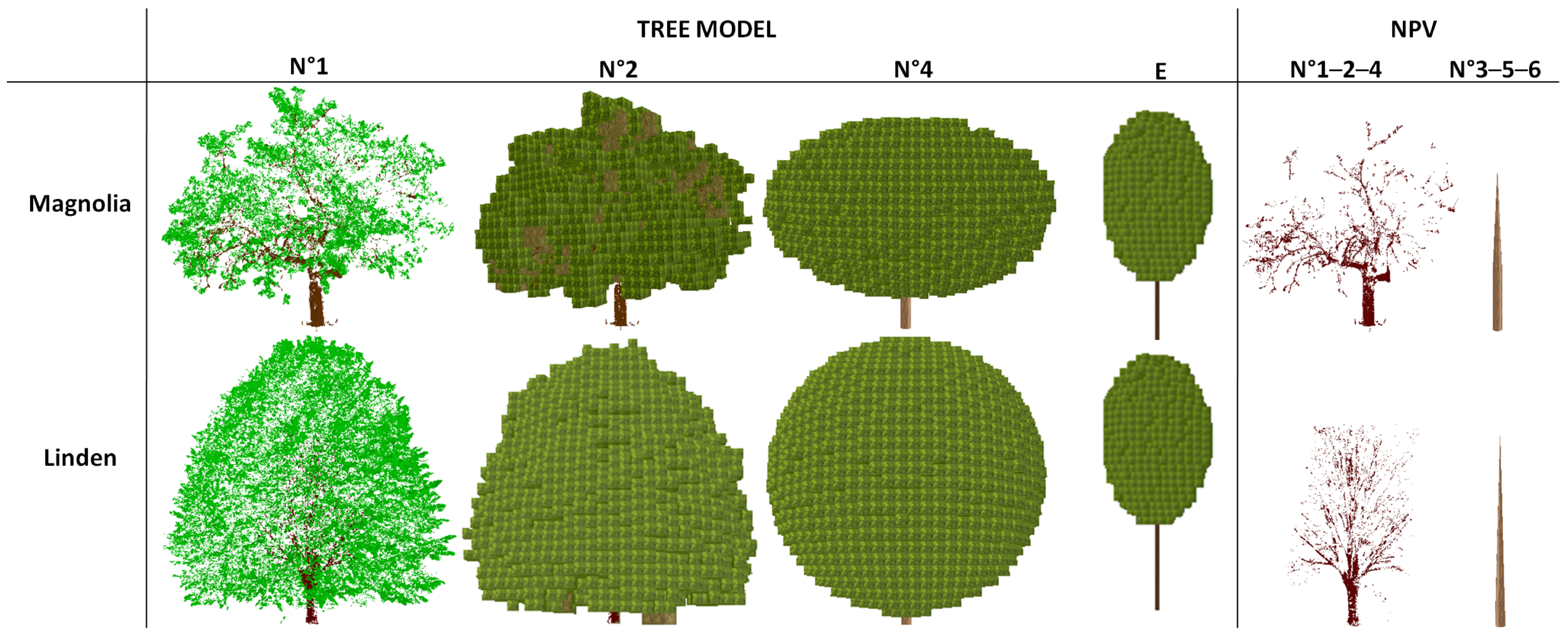
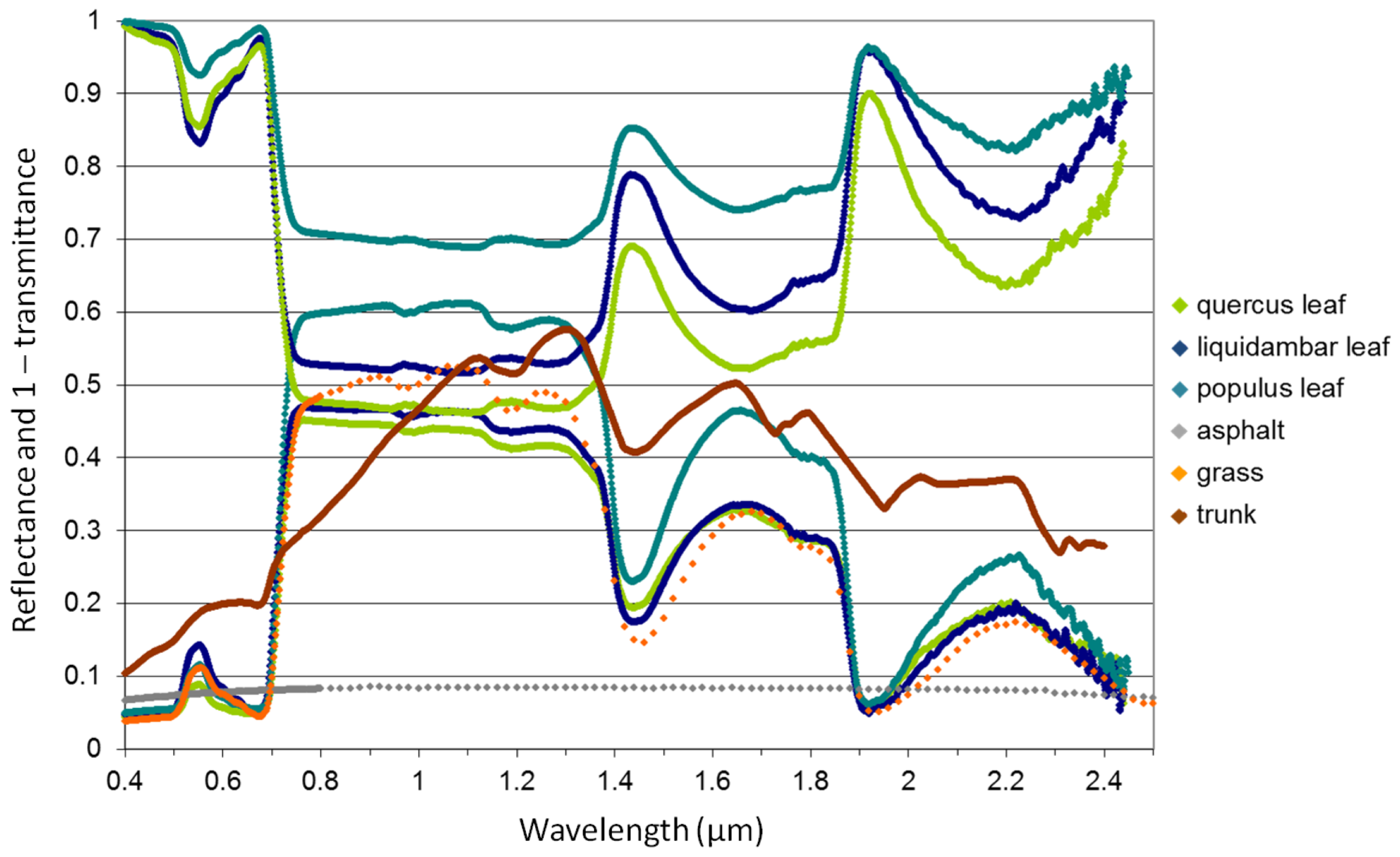

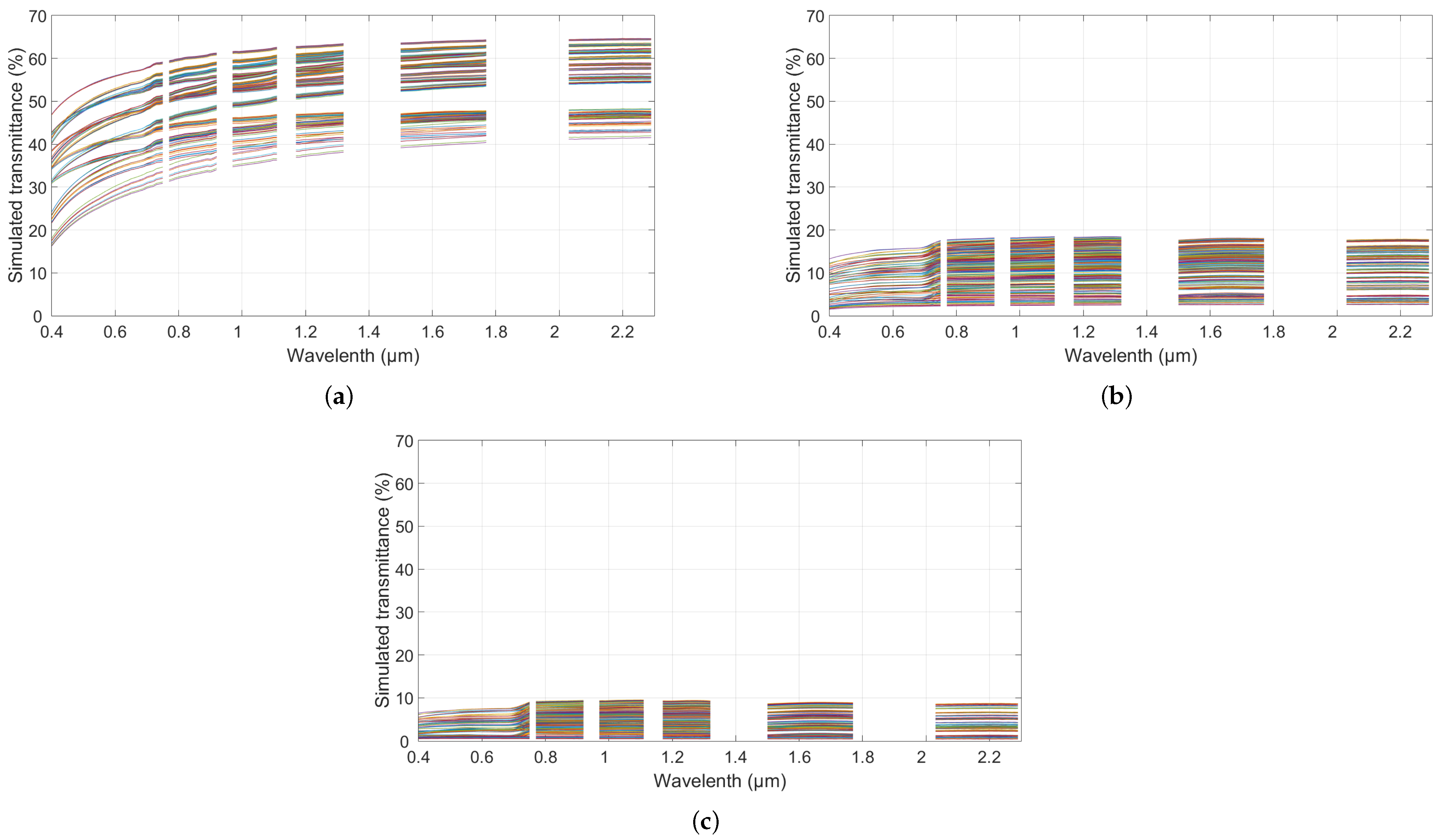

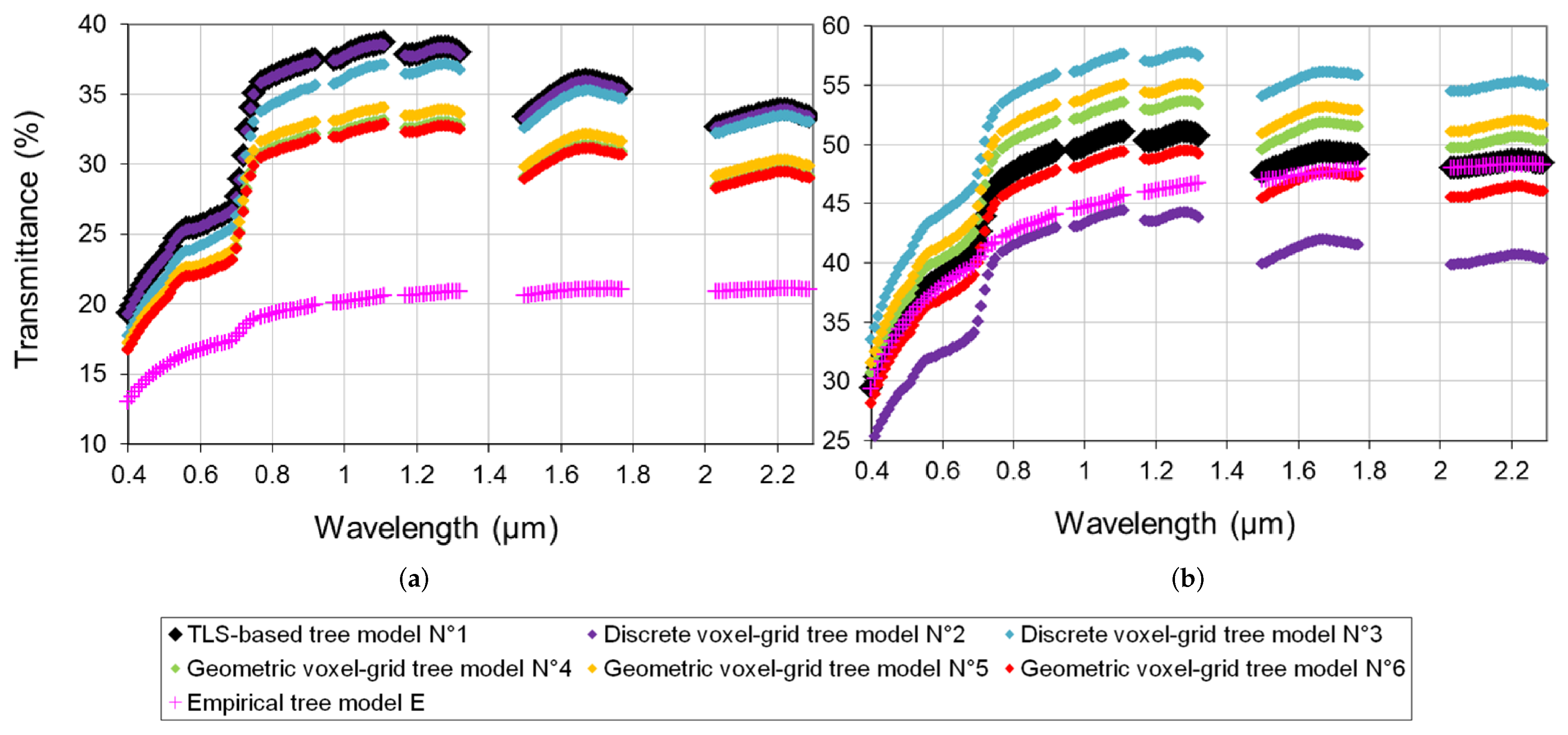
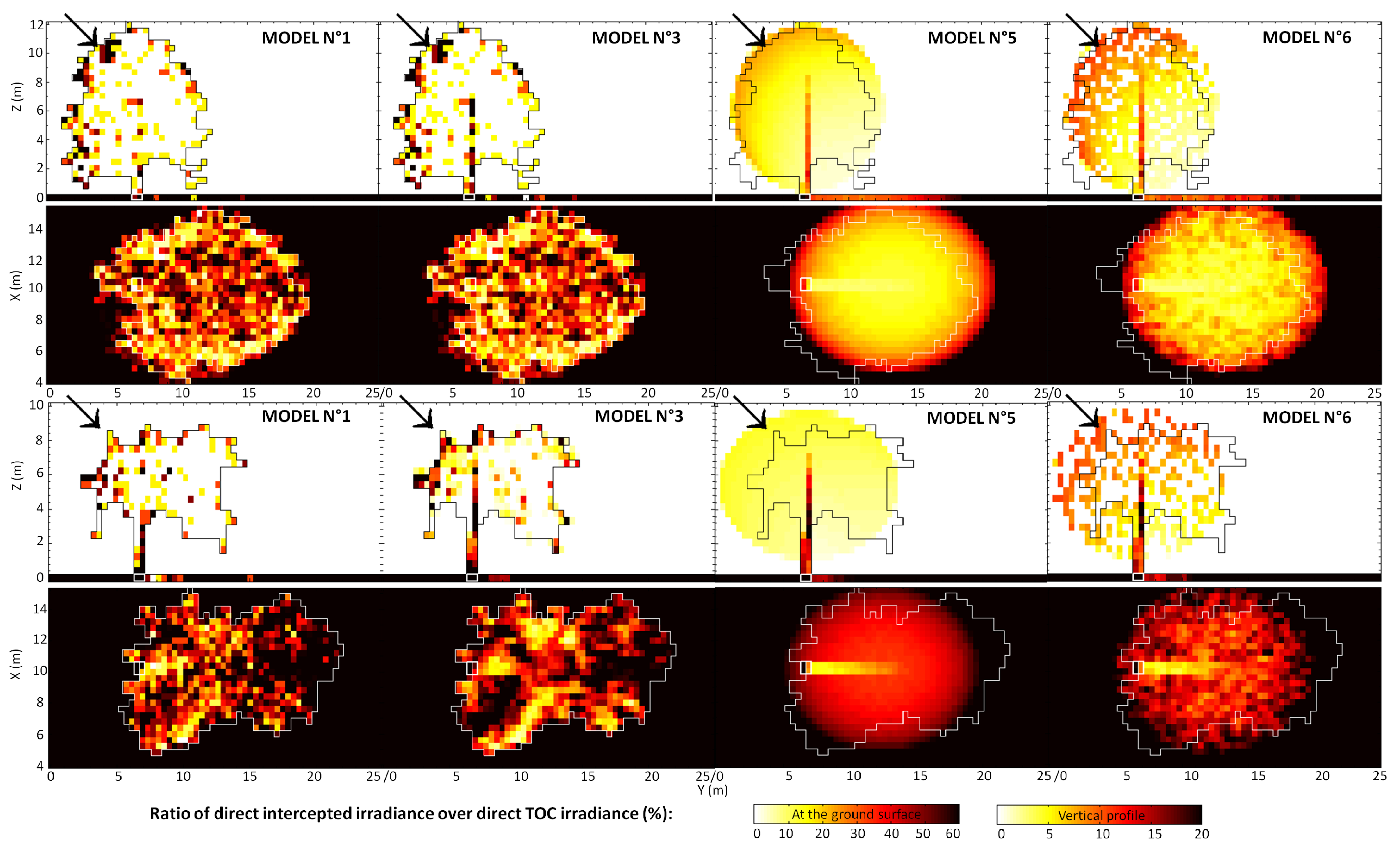

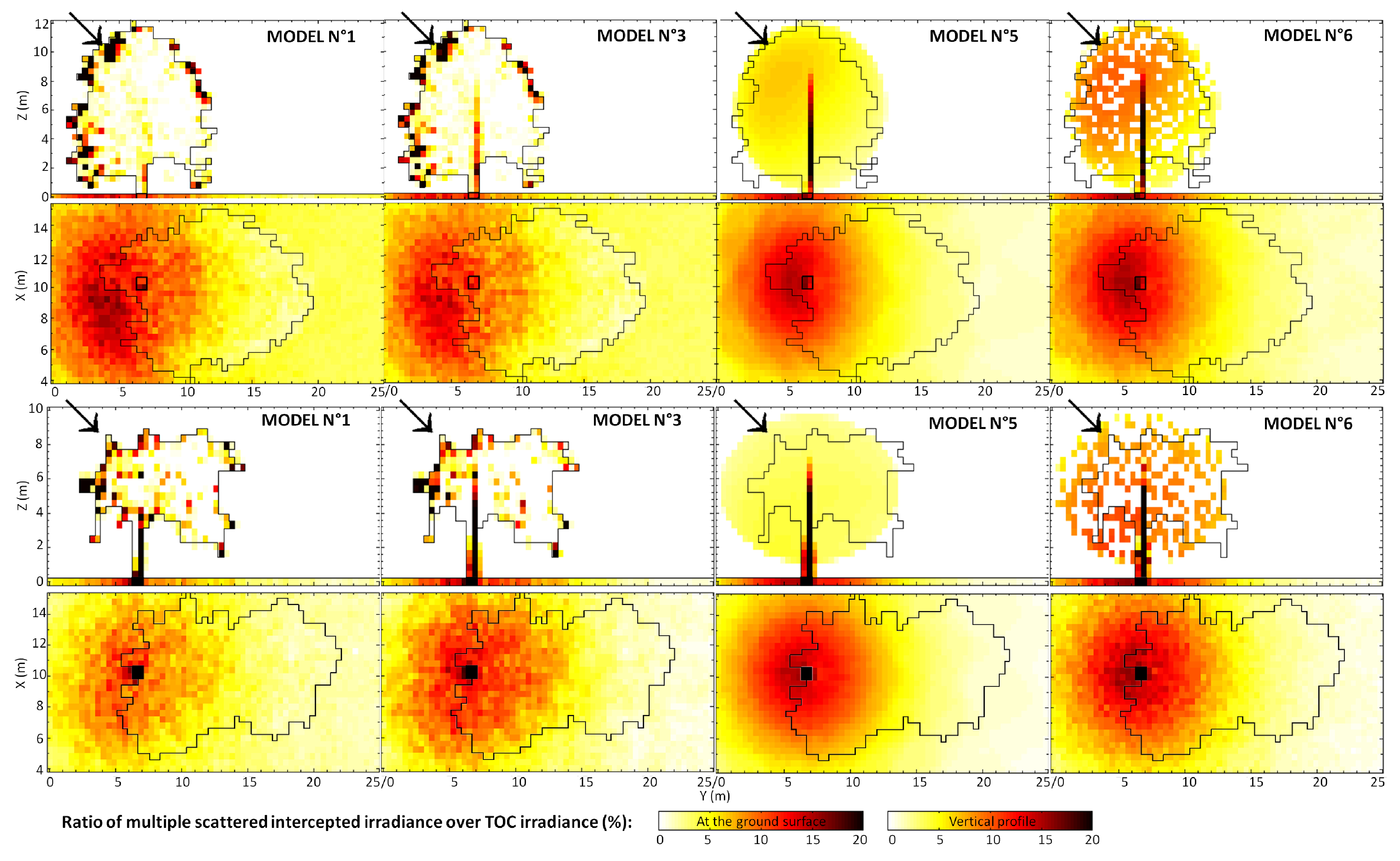
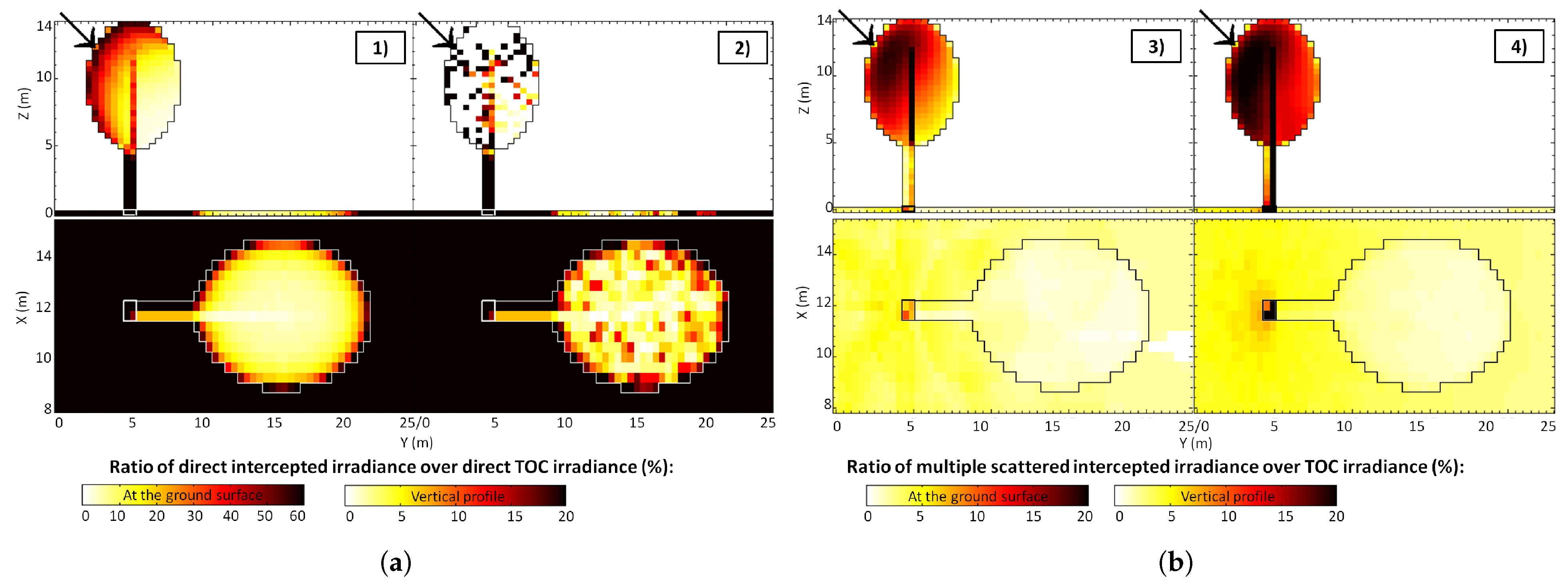

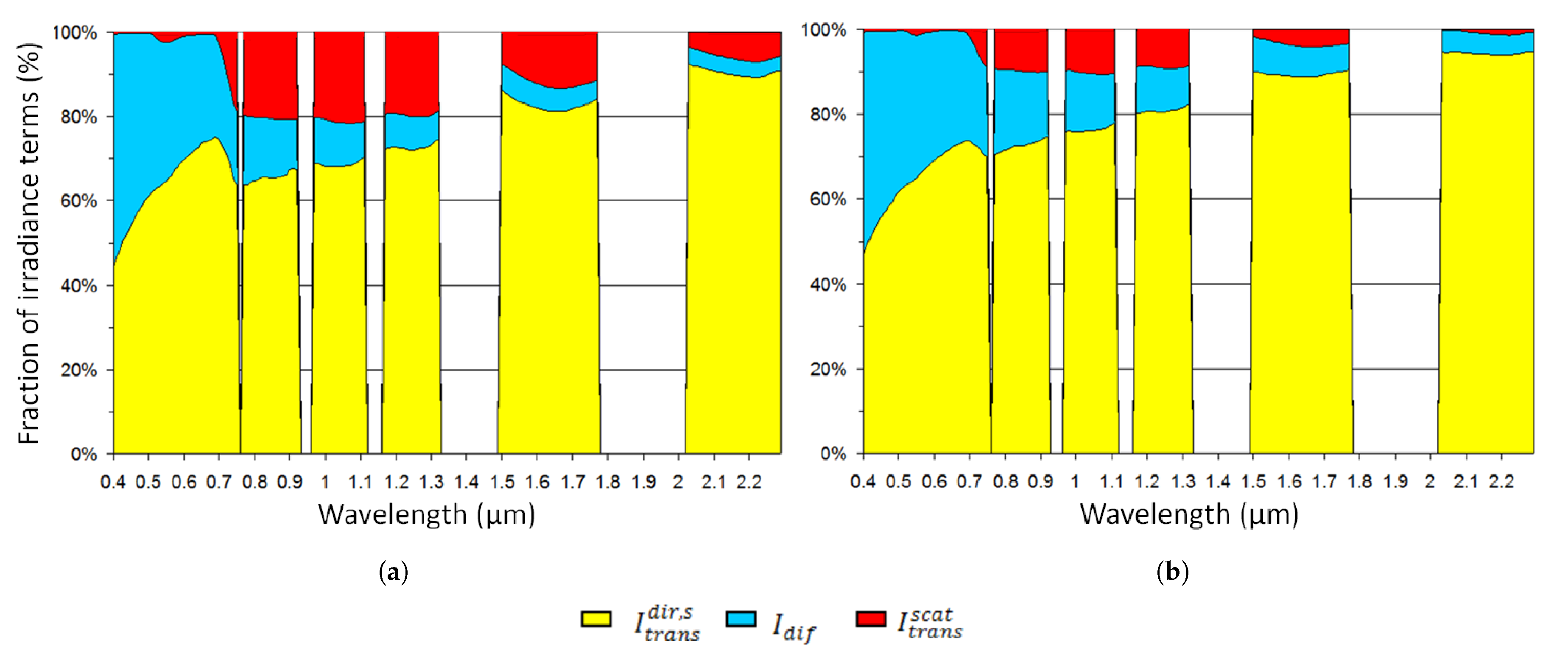
| Tree Model | 1 | 2 | 3 | 4 | 5 | 6 | E |
|---|---|---|---|---|---|---|---|
| (TLS-Based) | (Discrete Voxel-Grid) | (Discrete Voxel-Grid) | (Geometric Voxel-Grid) | (Geometric Voxel-Grid) | (Geometric Voxel-Grid) | (Geometric Voxel-Grid) | |
| Leaves (L), trunk (T) and branches (B) modeling | Triangles (L+T+B) | Turbid voxels (L) and triangles (T+B) | Turbid voxels (L) and geometric (T), no branch | Turbid voxels (L) and triangles (T+B) | Turbid voxels (L) and geometric (T), no branch | Turbid voxels (L) and geometric (T), no branch | Turbid voxels (L) and geometric (T), no branch |
| Tree height [m] | 9.48/11.56 | 9.48/11.56 | 9.48/11.56 | 9.65/11.90 | 9.65/11.90 | 9.65/11.90 | 14.2 |
| Crown ellipsoid dimensions in x, y, z [m x m x m] | - | - | - | 13.47 × 11.81 × 8.45 / 11.40 × 11.94 × 11.4 | 13.47 × 11.81 × 8.45 / 11.40 × 11.94 × 11.4 | 13.47 × 11.81 × 8.45 / 11.40 × 11.94 × 11.4 | 6 × 6 × 9.4 |
| Trunk cylinder height below & inside crown [m] | - | - | 1.2 & 6.34/0.5 & 8.55 | - | 1.2 & 6.34/0.5 & 8.55 | 1.2 & 6.34/0.5 & 8.55 | 4.8 & 7.2 |
| DBH [m] | - | - | 0.5/0.42 | - | 0.5/0.42 | 0.5/0.42 | 0.4 |
| Crown projected area [m2] | 117/119 | 98/97 | 98/97 | 125/107 | 125/107 | 125/107 | 28 |
| Crown volume [m3] | 339/669 | 280/581 | 280/581 | 704/812 | 704/812 | 281/579 | 177 |
| Tree Model | 1 | 2 | 3 | 4 | 5 | 6 | E |
|---|---|---|---|---|---|---|---|
| (TLS-Based) | (Discrete Voxel-Grid) | (Discrete Voxel-Grid) | (Geometric Voxel-Grid) | (Geometric Voxel-Grid) | (Geometric Voxel-Grid) | (Geometric Voxel-Grid) | |
| Tree LAI [m2.m−2] | TLS-fixed | TLS-fixed | TLS-fixed | (1.28/2.27) 1 | (1.28/2.27) 1 | (1.28/2.27) 1 | 0.5–1–1.5–2–2.5–3–3.5–4–6–8 |
| LAD (distribution: ALA [°]) | TLS-fixed | Computed (ellipsoidal: 63 / 51) | Computed (ellipsoidal: 63 / 51) | Simplified (spherical) 2 | Simplified (spherical) 2 | Simplified (spherical) 2 | Simplified (ellipsoidal: 30–57.58–70) |
| Leaf clumping or POROSITY [%] | TLS-fixed | Computed | Computed | Absent | Absent | Random distribution 3: 28.5 / 60 | Random distribution: 0–30–70 |
| Variable [Units] | Values | |
|---|---|---|
| Sun geometry | Zenith angle [°] (SZA) | 30–45–60 |
| Azimuth angle [°] | 90 (relative value) | |
| Sensor geometry | Zenith /Azimuth angles [°] | 0 / 0 |
| Spectral bands | Number 1 / range [µm] | 138 / 0.4–2.5 |
| FWHM 2 [nm] | Vis–NIR: 3.7 & SWIR: 6 | |
| Atmospheric conditions | Gaseous atmospheric profile | Mid-latitude summer |
| Aerosol type | Urban | |
| Visibility [km](VISI) | Tree model n°1–6: 23 Tree model E: 10–23 | |
| Scene | Dimensions in x, y, z [m × m × m] | Tree model n°1–6: Magnolia: 20 × 30 × 10 Linden: 20 × 30 × 12 Tree model E: - SZA < 60°: 22.8 × 22.8 × 14.0 - SZA = 60°: 30.8 × 30.8 × 14.0 |
| Voxel size in x, y, z [m × m × m] | 0.4 × 0.4 × 0.4 |
| Reference: TLS-Based Tree Model n°1 | ||||||||||||
| Linden | Magnolia | |||||||||||
| T | 30°/A | 30°/G | 45°/A | 45°/G | 60°/A | 60°/G | 30°/A | 30°/G | 45°/A | 45°/G | 60°/A | 60°/G |
| 2 | 0 | 0 | 0.1 | 0.1 | 0 | 0 | 6 | 5.9 | 7 | 6.9 | 8.2 | 8.1 |
| 3 | 0.9 | 1 | 1.1 | 1.2 | −1.5 | −1.6 | −5.2 | −5.2 | −6.3 | −6.2 | −6.4 | −6.4 |
| 4 | 7.4 | 7.5 | 4.5 | 4.6 | 4.4 | 4.6 | 3.1 | 3 | 1.8 | 1.8 | 1.7 | 1.7 |
| 5 | 7.1 | 7.1 | 4.3 | 4.4 | 3.6 | 3.7 | −0.7 | −0.8 | −2.1 | −2.1 | −1.8 | −1.8 |
| 6 | 6.3 | 6.4 | 3.6 | 3.7 | 3.6 | 3.7 | −2.2 | −2.2 | −3.5 | −3.4 | −3 | −3 |
| Reference: Empirical Tree Model E | ||||||||||||
| Linden | Magnolia | |||||||||||
| T | 30°/A | 30°/G | 45°/A | 45°/G | 60°/A | 60°/G | 30°/A | 30°/G | 45°/A | 45°/G | 60°/A | 60°/G |
| 1 | 17.7 | 19 | 12.6 | 13.6 | 24.6 | 25.2 | 9.5 | 10.3 | 1.6 | 2.3 | 14.2 | 14.6 |
| 4 | 10.6 | 11.8 | 8.3 | 9.2 | 21 | 21.5 | 10.2 | 11.1 | 3.7 | 4.4 | 16 | 16.4 |
| Reference: TLS-Based Tree Model n°1 | ||||||||||||
| Linden | Magnolia | |||||||||||
| T | 30°/A | 30°/G | 45°/A | 45°/G | 60°/A | 60°/G | 30°/A | 30°/G | 45°/A | 45°/G | 60°/A | 60°/G |
| 2 | 0 | 0 | 0.2 | 0.2 | 0 | 0 | 12 | 11.7 | 15.4 | 15.1 | 20.2 | 20 |
| 3 | 2.8 | 3 | 3.6 | 3.8 | 5.1 | 5.2 | 10.5 | 10.3 | 13.8 | 13.5 | 15.8 | 15.6 |
| 4 | 21.8 | 21.2 | 14 | 14 | 13 | 13.2 | 6.2 | 5.9 | 4 | 4 | 4.3 | 4.3 |
| 5 | 20.8 | 20.2 | 13.4 | 13.4 | 10.4 | 10.6 | 1.3 | 1.4 | 4.6 | 4.6 | 4.5 | 4.4 |
| 6 | 18.6 | 18.1 | 11.1 | 11.1 | 10.4 | 10.6 | 4.4 | 4.4 | 7.6 | 7.4 | 7.4 | 7.3 |
| Reference: Empirical Tree Model E | ||||||||||||
| Linden | Magnolia | |||||||||||
| T | 30°/A | 30°/G | 45°/A | 45°/G | 60°/A | 60°/G | 30°/A | 30°/G | 45°/A | 45°/G | 60°/A | 60°/G |
| 1 | 51.3 | 52.8 | 39 | 40.5 | 74.1 | 74.5 | 18.9 | 20.2 | 3.4 | 4.7 | 35.1 | 35.7 |
| 4 | 38.5 | 40.8 | 29.5 | 31.4 | 71.1 | 71.5 | 20 | 21.3 | 7.7 | 8.8 | 37.9 | 38.4 |
| Neglecting Tdir | Neglecting Tscat | |||||||
|---|---|---|---|---|---|---|---|---|
| Linden | Magnolia | Linden | Magnolia | |||||
| T | Red (0.67 µm) | NIR (0.8 µm) | Red (0.67 µm) | NIR (0.8 µm) | Red (0.67 µm) | NIR (0.8 µm) | Red (0.67 µm) | NIR (0.8 µm) |
| 1 | 99.6 | 75.6 | 99.5 | 89.5 | 16.4 | 10.5 | 7.6 | 4.0 |
| 2 | 99.6 | 75.6 | 99.1 | 85.5 | 16.4 | 10.6 | 9.6 | 6.4 |
| 3 | 99.6 | 77.0 | 99.4 | 88.4 | 14.5 | 10.6 | 12.0 | 21.4 |
| 4 | 99.5 | 75.8 | 99.2 | 87.3 | 9.9 | 30.0 | 5.3 | 20.9 |
| 5 | 99.6 | 75.8 | 99.2 | 87.2 | 10.8 | 30.8 | 6.3 | 21.7 |
| 6 | 99.6 | 76.3 | 99.1 | 86.9 | 10.3 | 30.0 | 3.0 | 19.4 |
Publisher’s Note: MDPI stays neutral with regard to jurisdictional claims in published maps and institutional affiliations. |
© 2021 by the authors. Licensee MDPI, Basel, Switzerland. This article is an open access article distributed under the terms and conditions of the Creative Commons Attribution (CC BY) license (http://creativecommons.org/licenses/by/4.0/).
Share and Cite
Adeline, K.R.M.; Briottet, X.; Lefebvre, S.; Rivière, N.; Gastellu-Etchegorry, J.-P.; Vinatier, F. Impact of Tree Crown Transmittance on Surface Reflectance Retrieval in the Shade for High Spatial Resolution Imaging Spectroscopy: A Simulation Analysis Based on Tree Modeling Scenarios. Remote Sens. 2021, 13, 931. https://doi.org/10.3390/rs13050931
Adeline KRM, Briottet X, Lefebvre S, Rivière N, Gastellu-Etchegorry J-P, Vinatier F. Impact of Tree Crown Transmittance on Surface Reflectance Retrieval in the Shade for High Spatial Resolution Imaging Spectroscopy: A Simulation Analysis Based on Tree Modeling Scenarios. Remote Sensing. 2021; 13(5):931. https://doi.org/10.3390/rs13050931
Chicago/Turabian StyleAdeline, Karine R. M., Xavier Briottet, Sidonie Lefebvre, Nicolas Rivière, Jean-Philippe Gastellu-Etchegorry, and Fabrice Vinatier. 2021. "Impact of Tree Crown Transmittance on Surface Reflectance Retrieval in the Shade for High Spatial Resolution Imaging Spectroscopy: A Simulation Analysis Based on Tree Modeling Scenarios" Remote Sensing 13, no. 5: 931. https://doi.org/10.3390/rs13050931









